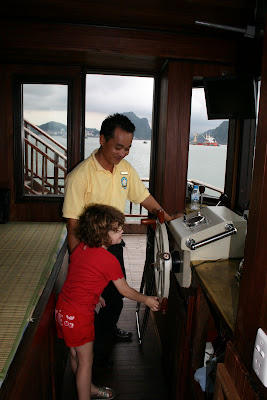Having lived in Hanoi now for a couple of months we thought it was time to start and visit one of the museums here to learn more about the culture in Vietnam.
We were surprised at what we found and how interesting the museum was.
Information about the museum from the Internet.........
"The Vietnam Museum of Ethnology is a valuable centre for the exhibition and the preservation of cultural heritages of the 54 ethnic groups in Vietnam. To date, the Museum has collected 15,000 artifacts, 2,190 slides, 42,000 photographs, 237 audiotapes, 373 videotapes and 25 CD-ROMs. It is also a centre for ethnographic research employing many experts on the different ethnic groups. People come to the Museum just not to visit or entertain, but also to learn about these ethnic groups, their cultural diversity and the uniqueness of each group and region, as well as traditional values throughout the Vietnamese country.
The artifacts of the Museum are not only priceless antiquities, but many are everyday objects, such as knives, baskets, garments, flutes, pipes and mats. These objects reflect tangible and intangible cultural heritages of the communities, representing lives and creative activities of the people. Thus, artifacts of the Museum are so varied that they are organised into different collections. The Museum has 54 collections of each individual ethnic group. Functionally classified, there are collections of clothing, jewellery, of agricultural tools, fishing instruments, weapons, household utensils and musical instruments. In addition, there are collections of artifacts related to the various religions, beliefs, wedding ceremonies, funeral ceremonies and other social and spiritual activities.
The outdoor exhibition area is only large enough for the most popular architectural styles to be represented. Already presented are the Ede long house, the Tay stilt house, the Yao house half on stilts, half on earth, the Hmong house whose roof is made of pomu wood, the Viet house with tile roof and the Giarai tomb. There are future plans to present the Bahnar communal house, the Cham traditional house and the Hanhi house made with beaten walls. Between the houses, there are trees indigenous to the area of each house, zigzagging paths and a meandering stream crossed by small bridges. The outdoor museum is being realised step by step".

Picture: Paige and Ben sitting outside the museum
 Picture: Paige looking at a bike display of cane items
Picture: Paige looking at a bike display of cane items
Picture: A display on the stages of making of traditional hats

Picture: Bernadette & Paige standing next to a large clay pot

Picture: A display of traditional skirts
 Picture: A display of a traditional dress
Picture: A display of a traditional dress
Picture: Ben & Paige standing in front of one of the a traditional houses

Picture: Ben , Paige & Bernadette sitting in a traditional long house Picture: Looking down inside a traditional long house
Picture: Looking down inside a traditional long house
Picture: A traditional burial tomb

Picture: Information on family altars




 Picture: Bernadette & Ben on top deck of boat
Picture: Bernadette & Ben on top deck of boat



















